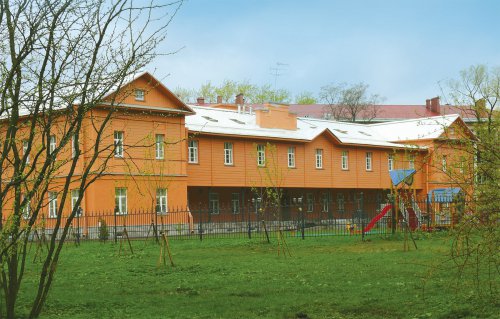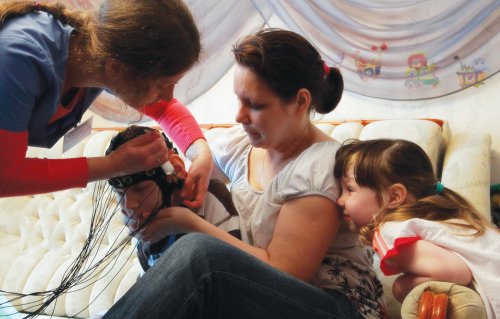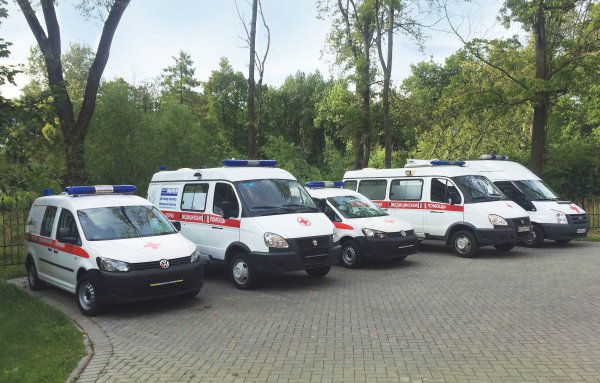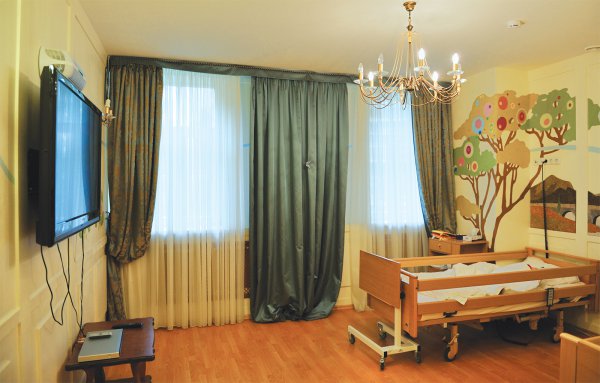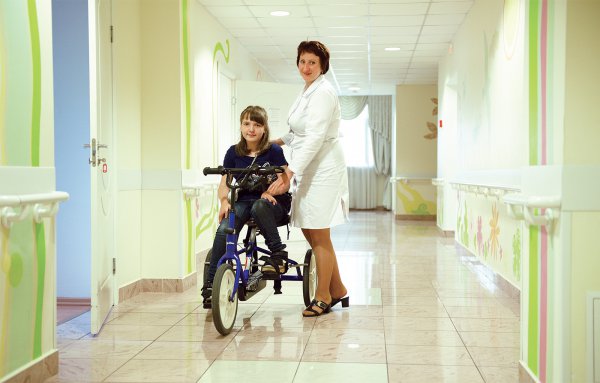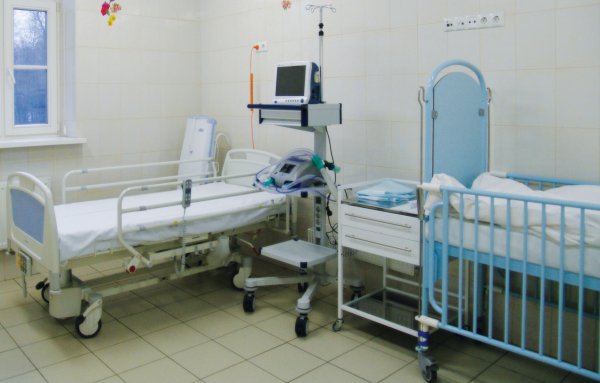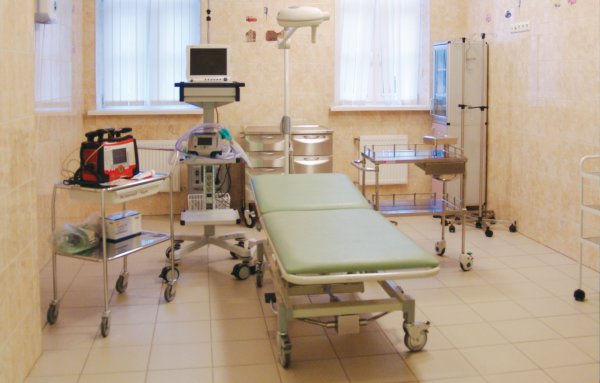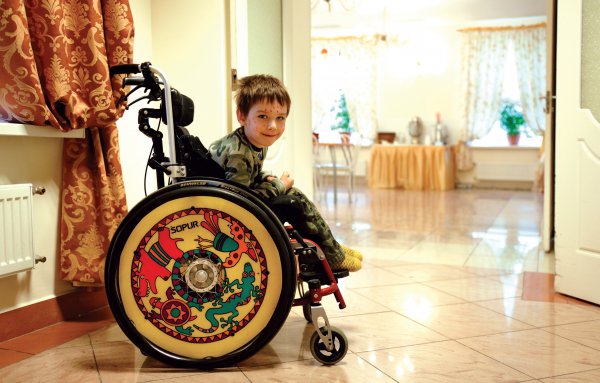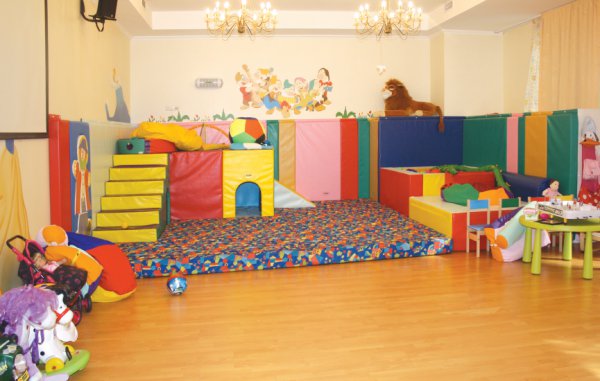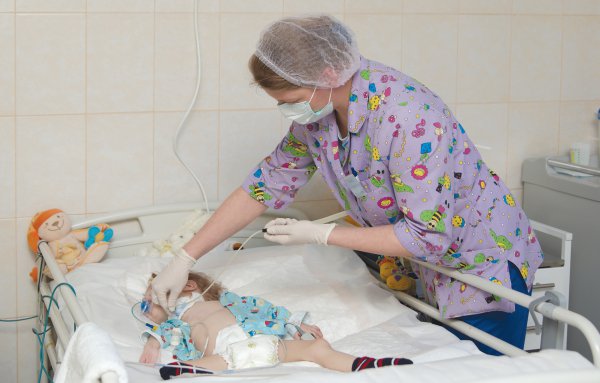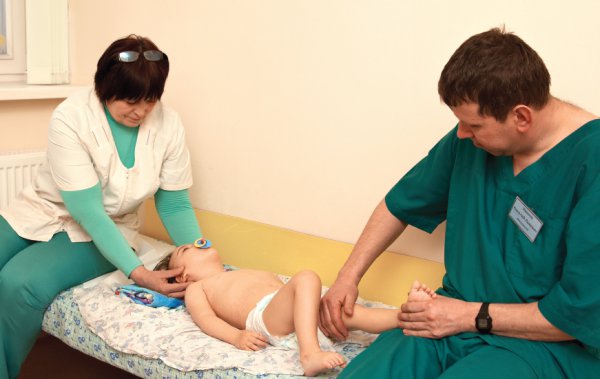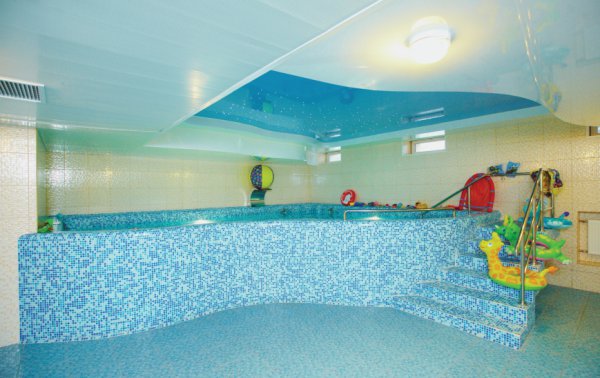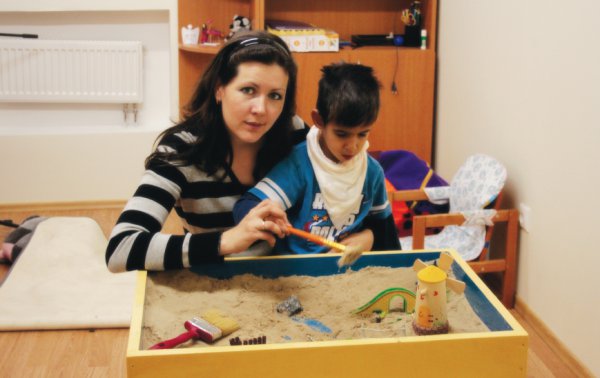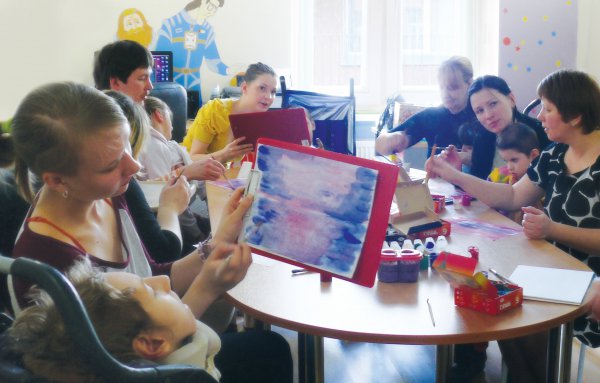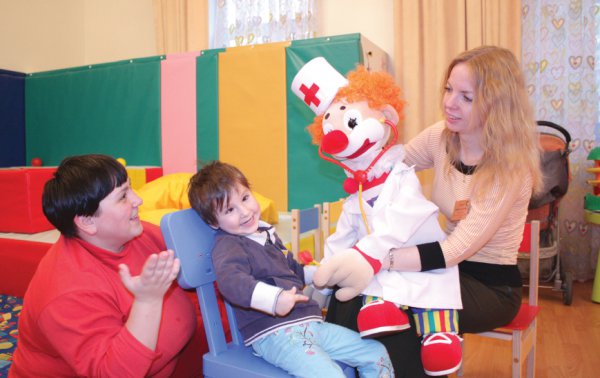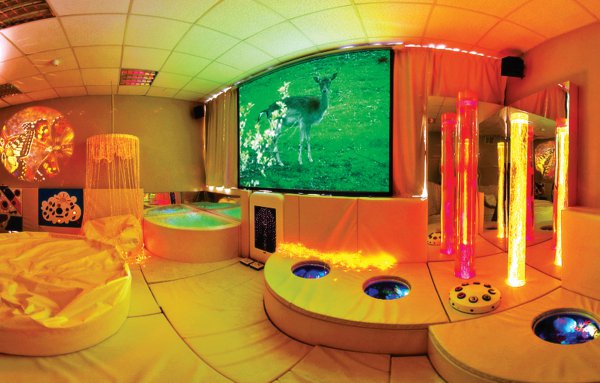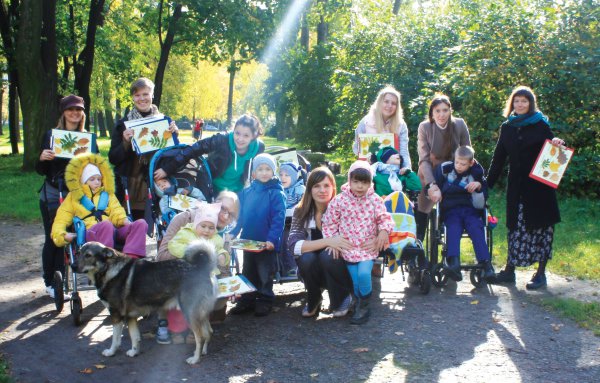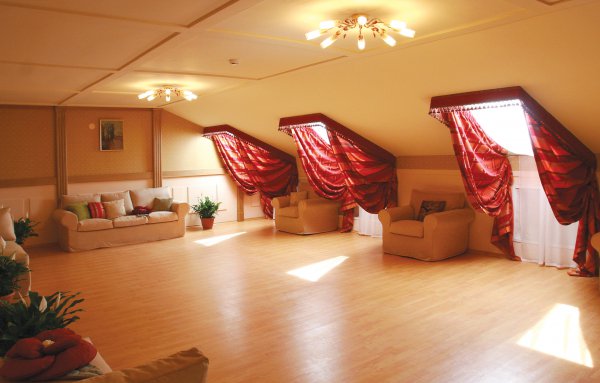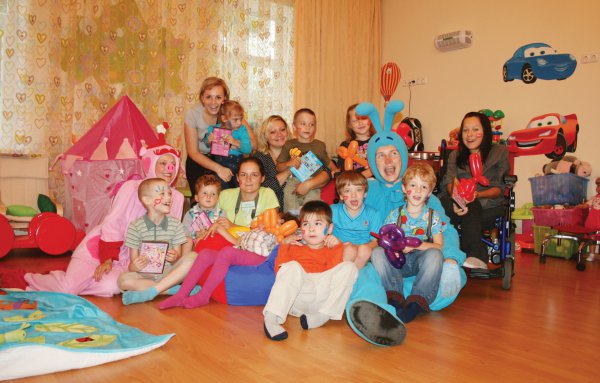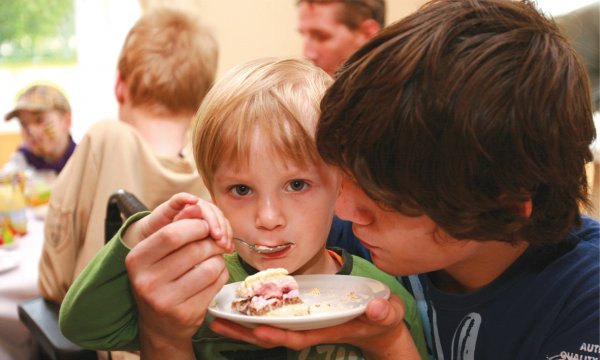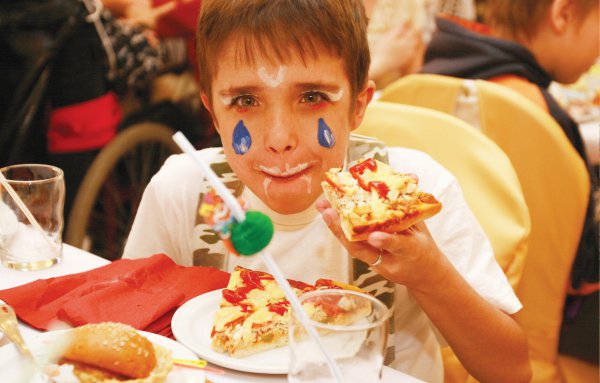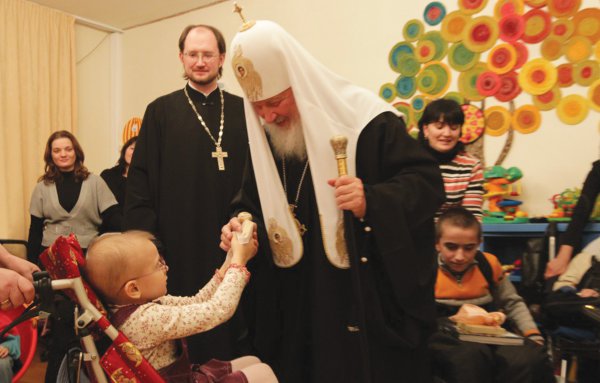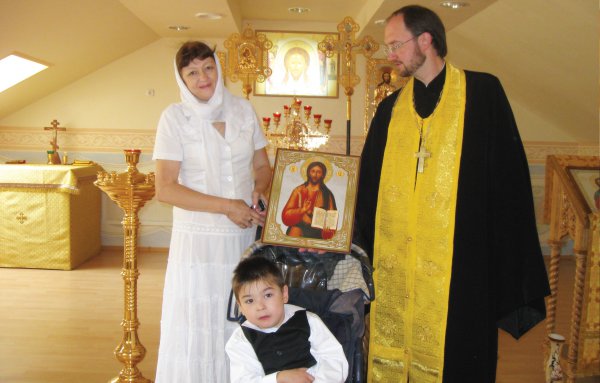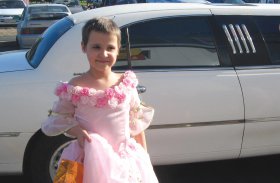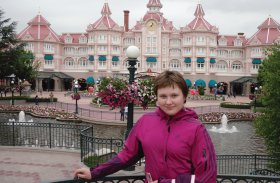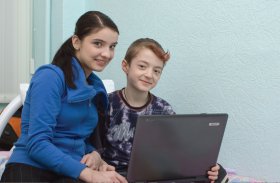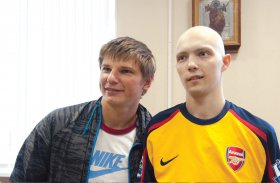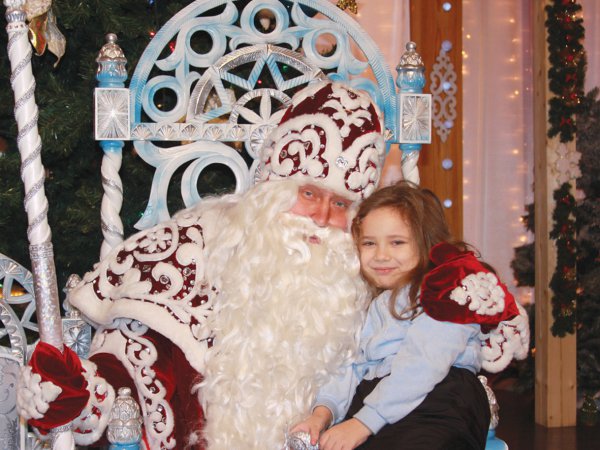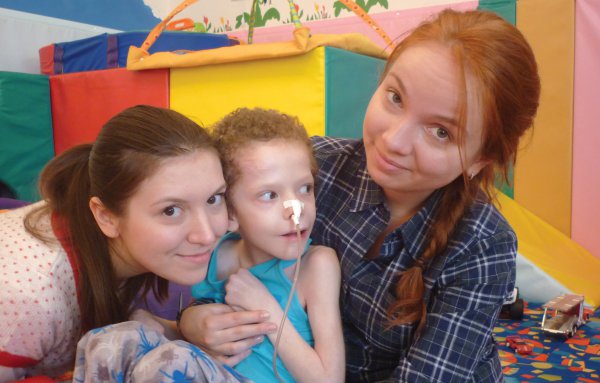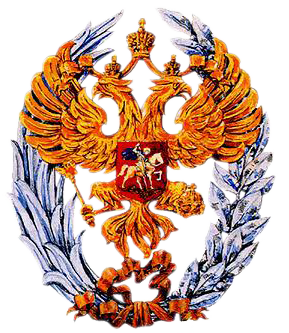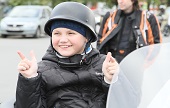Children's Hospice
God did not promise days without pain,
Laughter without tears, sun without rain...
But He promised to give strength for every day,
Console the crying and shed light on the way of the going.
Laughter without tears, sun without rain...
But He promised to give strength for every day,
Console the crying and shed light on the way of the going.
Dear Friends of Children’s Hospice!
 Thank you for your work and help that allow Children’s Hospice to continue its work aimed at improving the quality of life of hospice patients and their families.
Thank you for your work and help that allow Children’s Hospice to continue its work aimed at improving the quality of life of hospice patients and their families.After twelve years of work, a small charitable organization founded by the St. Petersburg Diocese of the Russian Orthodox Church has grown into the national leader of pediatric palliative care. We opened a cozy and comfortable facility for rehabilitation and palliative medicine. Children’s Hospice specialists have extensive experience in clinical care and are people of brilliant mental qualities. Their careful hands provide children with everything they need. Children receive timely medicines and care.
Children’s Hospice has become a model for establishing similar health and social care services in Russia.
I am infinitely grateful to all who have supported our activities for all these years. We dare to hope that your help will continue in the future.
Rev. Alexander Tkachenko General Director of Children’s Hospice
Introduction
Children are our finest teachers. They already know how to grow, how to develop, how to learn, how to expand and discover, how to feel, laugh and cry
and get mad, what is right for them and what is not right for them, what they need. They already know how to love and be joyful and to live life to its fullest,
to work and to be strong and full of energy. All they need is the space to do it.
Violet Oaklander
On June 1, 2010, on the seventh anniversary of Children’s Hospice, its Inpatient Facility was opened in St. Petersburg.
The story of the appearance of the Magic House for seriously ill children in our city is the story of a dream that has come true. Twelve years ago this
dream was born in the soul of the man who is now director of Children’s Hospice – Orthodox priest Alexander Tkachenko. Never abandoning his dream, he inspired people not to be indifferent and to work with him for the sake of its implementation.
The way that Children’s Hospice was accomplished was long and difficult.
Children’s Hospice under the leadership of Father Alexander began its work in 2003 as a home-based care service consisting of doctors, nurses, social workers and psychologists. The hospice was called upon to provide palliative care for terminally ill children and their families. We knew that the essence of palliative care is to maintain where it is impossible to cure. But almost no one, except our youngest patients, could teach us at that time exactly the kind of care and support they needed.
Coming to the families, we felt how lonely they are in their trouble and realized that our main goal is always to be near them. Being near them means to overcome difficulties together, maintain them in hard times and help family members learn to fully communicate with each other.
It also means to make their lives more satisfying, interesting, and joyful, as far as possible...
During the first years of work, our care for the children included regular home visits and various outing activities. It was also necessary to organize medical care at home. Almost all of our patients needed specific medical care, which they could not receive in the city hospitals. This was especially true of children in the most severe, terminal stage of disease. “Nobody needs us with our children, only you can help us”, the parents told us. Using all possible opportunities and acquiring new knowledge, hospice workers helped children at home and believed that someday they would have the possibility to do it in our own hospital.
Starting to work with 20 seriously ill children, we were confident that everything in their lives should be of the best quality. Now, when Children’s Hospice cares for about three hundred families, we will not part with that belief, because no one else needs this as much as they do. Because of the infinite amount of losses, pains and unrealizable desires which they must go through, every day needs to be counterbalanced by an infinite number of joys.
We wanted to establish a facility which would become a second home for them and which would not be similar to a hospital at all but be truly magical. After all, there are always joys and miracles in fairy tales.
The appearance of Children’s Hospice Inpatient Facility in St. Petersburg was preceded by many years of work and lots of efforts by many patient and good people. This intention was so important and significant that it was apparently destined to be realized with God’s help. Valentina Matvienko, St. Petersburg Governor, supported construction of Children’s Hospice Inpatient Facility in the city park “Kurakina Dacha” near St. Petersburg River Station. And one day, like in true fairy-tales, an old, half-ruined building turned into a beautiful, warm and welcoming home.
Every day, this Home carefully receives young patients and their families. Infinite human warmth and engagement will never be replaced with annoyance and lack of attention in the House. Our patients will never hear the cruel words that many of them have heard in the city hospitals and will never be able to forget. In this House we can ease the pain – not just by medicine, but by Soul. Everything in it was created for the sake of Life and to live, despite anything. Everything in it was designed to ensure that the children would not feel fear, pain and loneliness even in the most difficult moments of life.
This is probably possible because everything created in it was created with Love.
Basic concepts
A person needs you to be with him in his grief, at the bottom of this grief together with him, and not to be convinced that there is no sorrow or that he is
wrong in his grieving. Let God’s grace and inner experience of the person have time to do something.
Metropolitan Anthony of Sourozh
If there is a seriously ill child in your family, If there is a seriously ill child in the family of your friends or acquaintances,
If you or your friends want to help and render support to seriously ill children and their families – You may be interested in more detailed information about the activities of Children’s Hospice and hospice care features. To make our communication more effective, it is important to uncover the meaning of several little
known concepts that may bother you.
In hospice, terminally ill patients receive adequate care. Hospice patients are surrounded by ordinary domestic belongings; they may be visited at any
time by relatives and friends. Hospice staff provides symptomatic care.
It is sometimes thought that hospice and palliative care are the same thing. This is not quite right.
Hospice is the basic structure of palliative medicine that is designed to help seriously ill people in a terminal state, in which they have days and
months to live rather than years.
Palliative care is a complex of measures aimed at improving the quality of life of the patient and his family, facing the problems caused by a lifelimiting
disease.
The term “palliative” means “covering” and can be figuratively described as “shrouding with care and concern, accompanying.” In addition to medical care in fighting pain syndrome and other ailments related to disease, palliative care includes psychological, social and spiritual care of the patient and his family.
In 1987, palliative care was recognized as a separate section of medicine, and in 1990 the World Health Organization (WHO) first identified palliative
care as an active aid to the patient whose disease does not respond to specific treatment.
Palliative care provides for prevention and relief of suffering by means of early detection, adequate evaluation and elimination. Palliative care improves
the quality of life and can thus positively influence the patient’s condition and course of the disease.
The postulates of palliative care:
- Timely and adequate relief of pain that brings suffering – one of the principal directions of action.
- Attitude toward life and death as a natural process.
- Absence of activities that contribute to the acceleration of patient death or extension of his life.
- Inclusion of psychological and spiritual aspects of care into the set of core measures.
- Using the expertise of various specialists for building the most efficient family support system.
Palliative care offers a support system, through which:
— the patient receives the opportunity to live life to its fullest despite the incurable disease;
— family can more easily solve various problems during the patient’s disease.
Life-limiting diseases are conditions caused by various pathological processes and inevitably leading to death. In this case there is no hope for a cure,
as the curative medicine (aimed at cure) is not effective. These diseases cause progressive deterioration of the child’s state and conditions, which leads to
increasing dependence on outside assistance, in particular from parents and medical staff.
Palliative care is provided to children whose lifetime is limited by:
Conditions associated with metabolic disorders (e.g., mucopolysaccharidoses (MPS), cystic fibrosis);
Diseases of blood and blood-forming organs (e.g., leukemia);
Diseases of the nervous system and sensory organs (e.g., cerebral palsy, etc.);
Diseases of cardiovascular system (e.g., inoperable heart defect);
Diseases of the gastrointestinal tract (e.g., chronic hepatitis, cirrhosis);
Congenital malformations and chromosomal and genetic diseases (e.g., trisomy 18);
Malignant neoplasms;
Progressive benign brain tumors;
Injuries of the loco-motor apparatus with severe dysfunction of the brain and spinal cord.
St. Petersburg Children’s Hospice is an institution of pediatric palliative care for children and adolescents under the age of 18 years, suffering from
terminal illnesses in the terminal phase and having a short life expectancy, as well as children and adolescents who suffer from potentially fatal diseases,
whose recovery is possible but unlikely and whose life span can be many years.
Children’s Hospice renders an active and comprehensive care, which includes the physical, psychological, emotional, social and spiritual spheres of aid. The basic attention is focused on providing the best possible quality of life and comprehensive care for the whole family.
Children’s Hospice Care Structure
... There’s no solution to life except to live it.
It’s as if they’ve invented another hospital instead of this one which really exists. They pretend you only go to hospital to get better. But really you come
here to die too…
Eric-Emmanuel Schmitt “Oscar and the Lady in Pink”
It’s as if they’ve invented another hospital instead of this one which really exists. They pretend you only go to hospital to get better. But really you come
here to die too…
Eric-Emmanuel Schmitt “Oscar and the Lady in Pink”
Home-Based Care service
Home-Based Care service has existed since the early days of Children’s Hospice work. Its activities include:
- regular visits by physicians, nurses, psychologists, and social workers to families under hospice care;
- providing emergency medical assistance to families at home;
- consultations by specialists at home;
- activities of an integrated socio-psychological rehabilitation.
Around-the-Clock Care Station
Around-the-Clock Care Station is designed for 20 patients. Period of stay depends on the individual needs of children and families.
The main goals we strive to achieve through the hospitalization of a child in the Around-the-Clock Care Station are:
- Stabilization of the health state of the chronically ill when it worsens;
- Possibility of short rest for parents giving care to the child for a long time.
In addition, the Care Station provides for medical, social and psychological rehabilitation of children. Parents have an opportunity to receive expert advice in organizing care for the child at home, to learn some methods of social adaptation of the child and to use them on their own in the future.
The interior of the Around-the-Clock Care Station is thought out very well. It does not have any wards with distressing white walls, but it has cozy living rooms for children and their mothers, decorated with cheerful drawings. Such cheerful surroundings help to improve the emotional state of hospice patients.
Intensive Care Unit
The Intensive care unit has wards for around-the-clock observation of children whose disease has reached the terminal stage. The department is equipped with the most modern equipment.
Day Care Center
Patients of the Day Care Center are provided with the same services as the children in the Around-the-Clock Care Station. Various forms of rehabilitation and therapy can be administered to the fullest extent, without staying in Children’s Hospice for the night.
Children’s Hospice Services
You should be like a musical chord, which itself does not emit any sound,
but as soon as a man’s finger touches it, it begins to sound: to sing or cry...
If a doctor behaves towards his patient such way, he creates a completely
new relationship...
Metropolitan Anthony of Sourozh
but as soon as a man’s finger touches it, it begins to sound: to sing or cry...
If a doctor behaves towards his patient such way, he creates a completely
new relationship...
Metropolitan Anthony of Sourozh
Medical assistance
Medical assistance includes the regular monitoring of sick children at home and in the Children’s Hospice Inpatient Facility, as well as consultations and symptomatic therapy.
All Hospice doctors are highly qualified specialists. In addition, they know how important it is in medicine in general and in palliative care in particular, to provide undivided attention and genuine concern to the sick person and his family.
In their work, doctors use an individual approach to each child, trying to ease his condition as much as possible.
Nursing care
Nursing care means conducting medical procedures and nursing manipulations aimed at improving comfort and life quality of both the child and his family, as well as training for parents caring for the sick child.
In addition to providing professional assistance, all Children’s Hospice nurses pay great attention to communication with patients. They are able to listen, to soothe, and to distract from sad thoughts.
In the course of communicating the nurse receives information about how the health condition and the mood of the child and his parents have changed and what kind of help the family needs at any given instant in time. Knowing the personality of the child and his family situation, nurses work out the most effective personal care plan for each patient. By the time of the Inpatient Facility opening, our nurses and doctors had acquired valuable experience and skills to work with such a difficult category of patients as hospice patients are. Now they do not just apply their knowledge and skills in the Inpatient Facility, but also share them with new staff and with colleagues from other organizations.
Consultations by specialists
Highly qualified oncologists, anesthesiologists, neurologists, nephrologists and other specialists cooperate with Children’s Hospice and actively participate in shaping the best treatment plan for the child.
Pain-fighting and symptom management
Unfortunately, no matter how hard it is to talk about this, some of the Children’s Hospice patients are in the final stages of their incurable disease. In these cases, anti-pain and symptomatic supportive therapy becomes especially important.
The Children’s Hospice staff, in close collaboration with parents and doctors of public clinics, tries to improve the health condition of the sick children as much as possible. The first priority is to conduct pain relief therapy. Modern diagnostic equipment and medical expertise allow us to determine the cause of pain and find adequate analgesia protocol.
Medical Rehabilitation
Medical Rehabilitation is a complex of measures aimed at restorative treatment and secondary prevention of disease, at increasing the body functionality, compensation for disturbed functions and return of lost skills. Inpatient Children’s Hospice provides such rehabilitation activities as therapeutic physical culture, massage, physiotherapy, aqua-therapy in a pool that is specially designed for children with disabilities, SPA-capsule.
The application of these procedures significantly improves the physical condition of many children, and, consequently, their emotional state becomes more positive.
Psychological Help
All families under hospice care are provided with highly qualified psychological care. Its main goal is to help children and their families, who have found themselves in this difficult life situation, learn to live every moment of life most consciously and emotionally fully, and to create and maintain close and trustful relationships with each other.
Contact with a severe illness and death is always scary, because it awakens in people the fear of their own death. When we talk about a child’s illness, the tragedy becomes many times harder. If there is a dying person at home, family friends and sometimes even family members often do not find the strength to communicate with him openly and sincerely, thereby they estrange from him. They do not know how to help him, and are afraid to upset him. They are burdened by the impossibility of easing his suffering and experience guilt feelings. So, they themselves are in need of help. However, for seriously ill children the presence of people whom they trust is even more important than for an adult. Endless attention and unconditional love are necessary in the life of every child, in particular of those suffering.
Hospice psychologists regularly visit and advise the children at home, monitor the psychological climate in the family, provide psychological support to parents and siblings. They conduct individual and group sessions with children in the Inpatient Hospice Facility using different methods of psychotherapy.
- Art therapy is a method of psychotherapy for treatment and psycho-correction which utilizes such techniques as painting, sculpture, music, photography, movies, books, stage acting, etc. Art therapy sessions facilitate the release of restrained feelings, problems, internal contradictions of the child or adult on one hand, and the creative self-expression on the other. In the process of creative activities, the child can manifest himself more brightly and clearly than in writing or in speech. The use of art therapy is especially important for patients who cannot “speak out”, because it easier to express one’s imaginations in creativity than to tell about them. Fantasies, which are represented on paper or made of clay, can often accelerate and facilitate the speaking out about feelings. In the process of creativity, the action of psychological defense mechanisms is reduced. As a result, the child can more correctly and realistically appraise his feelings about the surrounding world.
- One kind of art therapy is music therapy.
Music that is specially selected by a therapist engages a child or family in the most comfortable way into the common musical space. Participation in it can be active or passive: you can improvise and compose music, dream with the music, sing, move, follow the rhythm and dance. Such therapy can be effective in helping kids express or reveal complex feelings and sensations, be a means to cope with pain or depression, or just get distracted and obtain some pleasure.
Another kind of art therapy that is widely used in work with children is Play Therapy.
Play Therapy includes drawing, drama improvisation, puppetry, joint and individual games, etc. The game is a natural, self-regulating and self-treating
process. Every child is different, every story is unique. Just as with music and art, unexpressed feelings and experiences often find expression through the means of the game that the child chooses.
In addition, there is a possibility of individual therapy in the sensory room of Children’s Hospice.
The Sensory Room us a truly magical place. Everything in it – light, sound, surroundings – is intended to reassure, to help at least temporarily
escape from sad thoughts and enable one to rest. Special equipment installed in the sensory room affect all one’s senses. Lying in a “dry pool” or on soft pouffes, in the atmosphere of slowly swimming light, listening to soothing music, inhaling the aroma of herbs, a child or adult falls into the magical world. The feeling of complete safety and comfort is created in this room. Because of this, more calm and trusting relationships can be established between a specialist and a patient, and the therapy process becomes more efficient.
Sensory room allows performing the following procedures of the psychological impact:
- Relaxation, withdrawal of emotional and muscle tension of a child or adult.
- Stimulation of sensory sensitivity and physical activity for children, development of their visual and motor coordination.
- Recording and management of the child’s attention, maintaining his interest and cognitive activity.
- Toning child’s mental activity by stimulating positive emotional reactions.
- The development of imagination and creativity in children.
- Correction of psycho-emotional condition of the child or adult.
- Expanding child’s horizons, his spatial concepts, perceptions of various properties of objects.
Psychosocial Rehabilitation
Hospice social workers develop individual rehabilitation programs for each child, which include the organization of school education at home, leisure time, educational games with children, career guidance for teens, recruitment of volunteers, help in organizing family events, and fulfillment of a child’s treasured dreams. The programs are developed with consideration for the personality features and physical conditions of the child that are identified in the communication process, as well as his family situation and the social conditions of his life.
An integral part of these programs is the arranging of outing activities.
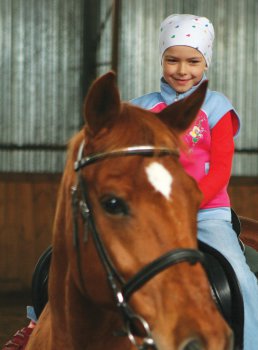 As far as opportunities and a child’s strength allow, we try to give children new experiences and knowledge, new opportunities for communication. Every day they get to know better the city in which they live. Children attend the best cultural and educational entertainment of St. Petersburg and Leningrad region.
As far as opportunities and a child’s strength allow, we try to give children new experiences and knowledge, new opportunities for communication. Every day they get to know better the city in which they live. Children attend the best cultural and educational entertainment of St. Petersburg and Leningrad region.Particular attention is paid to social and psychological support of children during their stay in the Inpatient Facility. Individual support programs include both participation in common activities, as well as daily individual sessions with psychologists and educators. Our primary goal is to reach out to every child, giving him the joy of communication, creativity and self-discovery.
For games and entertainment the children have at their disposal a big playroom with a variety of colorful toys, an educational computer class, and a zone of creativity.
In the attic of the Inpatient Facility there is a fireplace room with an extensive library. All patients have the opportunity to use the Internet and watch TV, without leaving their wards.
In good weather, walks in the park are organized for the children.
In the courtyard of the Inpatient Facility there is a playground, which is specially equipped for children with limited mobility, such as swings which can swing without moving from the wheelchair.
Hospice patients are aware that every day many people take care to make their days interesting, comfortable and happy ones. Each day spent at the hospice becomes an event for them, and the life they live there – really valuable.
Respite Care for Parents
 Most parents of seriously ill children constantly stand near the child from the moment he gets ill, trying to give him the best care and carefully watching his condition. Sometimes it lasts for years.
Most parents of seriously ill children constantly stand near the child from the moment he gets ill, trying to give him the best care and carefully watching his condition. Sometimes it lasts for years.Before the Children’s Hospice Inpatient Facility was built in our city, such parents had no possibility to keep the child under someone else’s care even for a short time. However, sometimes situations arise when there is an urgent need. It happens that a parent caring for the child is in need of treatment himself, needs a rest, may urgently need to go out of town on business, or needs to make repairs to the child’s room.
Children’s Hospice provides around-the-clock and professional care for children so that parents will not suffer from that constant feeling of concern for their child.
We offer parents our help, so that after a while they could care for their child with renewed strength and give him their love.
Family support during grieving time
Support during grieving time is a fundamental aspect of hospice work. Crisis psychological support for families should begin as early as the period when the child is in a terminal state, since this is an ordeal for all of his relatives.
Within 14 months after death of the child, if necessary even longer, Children’s Hospice psychologists and social workers support his parents and other family members. They are committed to helping close relatives of the child to maintain contact with each other and not to lock in their grief while coping with bereavement.
Providing children with necessary medications, sanitary and hygienic articles
All children, who are under observation in Children’s Hospice Inpatient Facility, are provided with sanitary and hygienic articles and all necessary medications, including painkillers.
Diet in Children’s Hospice Inpatient Facility
All patients of Children’s Hospice Inpatient Facility, as well as parents residing with them, are provided with a complete diet. Food that hospice cooks prepare can be called home cuisine according to its quality, and restaurant cuisine according to its diversity and sophistication. Particular attention is paid to the individual needs of each child. Chefs can cook Lenten, low-calorie food and foods cut into very small pieces, as well as special treats at the request of children.
Spiritual Support
All that the Lord sends us, we need to take with confidence in God.
The real strength of Christianity is in it.
Kirill, Patriarch of Moscow and All Russia
The real strength of Christianity is in it.
Kirill, Patriarch of Moscow and All Russia
Spiritual support – Pastoral Care – is the most important mission of Children’s Hospice as an organization initiated by the Russian Orthodox Church. In our work we adhere to the belief that spiritual well-being is equally important to man as is physical well-being, and that every human being is spiritual in his nature. Appealing to God, many people gain new strength to overcome the challenges they face during the child’s illness. Each of our patients and their families, when necessary, can meet with a priest. During this meeting they can share with him their memories, joys and sorrows, talk about their fears and doubts, talk to him about God,
the soul, the meaning of life and hope.
Such meetings can be organized at home and in Children’s Hospice.
The St. Luka chapel in Children’s Hospice Inpatient Facility, named after Archbishop Luka (born Valentin Felixovich Voyno-Yasenetsky, a Russian outstanding surgeon, a spiritual writer, a bishop of Russian Orthodox Church, canonized in Russian Orthodox Church in 2000), is open around the clock. Services are held regularly in the chapel and the sacraments are performed. We also arrange pilgrimages to the monasteries of the Leningrad region and beyond.
Spiritual support is provided to children and their parents regardless of their religion and faith. If one of our patients belongs to a different religion and needs to communicate with representatives of his religious community, we will try to assist in arranging this meeting.
Spiritual support is a kind of care which is sometimes not easy to define. The simplest expression of spiritual help is “the creation of meanings.”
In other words, it is the involvement of a man into the process which gives him the strength or an opportunity to understand the meaning and significance of ongoing events in his life. In practical terms, spiritual support is expressed by the fact that the priest will listen to you, be careful and be ready to be with you as long as you will need. At the same time, spiritual support is not a passive process but an active approach to support through relationships.
In a certain sense we can say that everything that happens at the Children’s Hospice is spiritual support.
Project “Dreams Come True”
When a heart conceals the seed of a flaming plant, a miracle,
that is the miracle to make happen – if one can.
The one you do it for will be reborn and so will you.
Alexander Grin, “Scarlet Sails”
that is the miracle to make happen – if one can.
The one you do it for will be reborn and so will you.
Alexander Grin, “Scarlet Sails”
The project “Dreams Come True” has been an important part of Children’s Hospice since its inception. In 2008, it became an All-Russian project.
Terminally ill children from the central regions of Russia and even from the most remote corners of our country tell their cherished dreams to the St. Petersburg Children’s Hospice staff.
And for every dream there is a good magician – an amazing person, who is ready to fulfill it and thereby to give a child the joy and the ability to believe in miracles that is so necessary for sick children in order to fight disease and live every day of their life as fully as possible. Every day of a life that can be so short...
What do our patients dream about? Each of the children dreams to get better. It is not in our power to help them do this, but we can ease their pain, help in
time, and bring necessary medication. Each of them wants to ease the heartache of their loved ones – and we try to support the entire family, give each child the opportunity to speak out, to find understanding and sympathy.
Each of them wants to be closer to people – and we acquaint them with good and interesting people. And there are some dreams, which a child thinks about
whenever he feels badly and is then dreamily smiling... There are dreams, which he could write to Santa Claus in the New Year’s letter, but would hesitate
to tell to his mother in order not to burden her already difficult life…
He convinces himself that these dreams are not serious, trying to be conscious and grown-up. But these dreams make him happier. Make it a real childhood.
Typically, these dreams are quite simple and do not seem unrealistic for an adult. We divide them into four main groups:
- Who do I want to feel myself (princess in a fairy-tale dress, manager, captain of a sailboat, etc.);
- Where do I want to go (to a theater or concert, to another country, etc.);
- What do I want to have (a long-awaited laptop and a live kitten, etc.);
- Whom do I want to meet (a favorite artist, athlete, musician, etc.).
During the twelve years of Children’s Hospice work, we have hundreds of times seen the happiest children’s eyes when cherished dreams were performed.
The children suffering from an incurable disease may not have time to become adults. Without our help, many of their dreams will never have a chance to come to fruition. The miracle must come into their life in time, now. Maybe then this life will last a little bit longer.
We know what it takes. We must earn the trust of the child, learn his most treasured dream and do everything possible to fulfill it...
Staff and volunteers of Children’s Hospice
The most important thing in a hospice is therapy through your presence.
A.Gnezdilov, professor, MD, Founder of the First Hospice for Adults in St. Petersburg
A.Gnezdilov, professor, MD, Founder of the First Hospice for Adults in St. Petersburg
Perhaps nothing can tell more about the people working in the Children’s Hospice than the trust and love that the children feel toward them.
It is true that children always know a fake. People, who constitute the staff of Children’s Hospice, are above all distinguished by such qualities as sincerity, openness, and willingness to help a child – not only by means of their professional skills, but also by means of their spiritual strength. Someone’s pain cannot be alien to these people, and their working time cannot be limited. What is happening in the hospice becomes an integral part of their lives.
Each employee has the education, qualifications and experience that are required to work in a hospice. Of course, it is important to note the inherent
ability of each hospice worker to work in partnership with others, to complement and support each other.
Volunteers
The Volunteer Service was established in Children’s Hospice to provide comprehensive assistance to families. Volunteer activities are carried out in the following areas:
- Help at home to care for children;
- Tutoring and creative activities for children;
- Transport services by private vehicle;
- Assistance and participation in children’s celebrations;
- Organization of long-term creative projects;
- Carrying out a series of thematic studies, and much more.
Before beginning their work in Children’s Hospice, volunteers undergo a special psychological training. Later, in the course of their work they can always count on help and support by hospice staff.
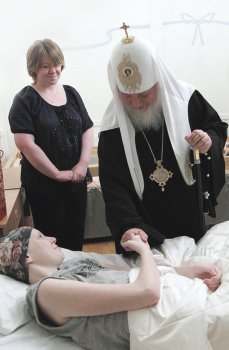 ”…I’ve long wanted to see what you did, but unfortunately I could not make it earlier. But today, in such a personal day for myself, on my birthday, I am happy to visit the hospice. You can believe me that this is perhaps the most beautiful gift that was given to me today. There are faces of doctors, staff persons and parents testifying to their courage and faith and of course children who are going through this suffering for reasons unknown to our human mind. But the Lord said, For my thoughts are not your thoughts, neither are your ways my ways (Isaiah 55, 8). We do not know the ways of divine providence, but through these children all of us can see some kind of special grace.
”…I’ve long wanted to see what you did, but unfortunately I could not make it earlier. But today, in such a personal day for myself, on my birthday, I am happy to visit the hospice. You can believe me that this is perhaps the most beautiful gift that was given to me today. There are faces of doctors, staff persons and parents testifying to their courage and faith and of course children who are going through this suffering for reasons unknown to our human mind. But the Lord said, For my thoughts are not your thoughts, neither are your ways my ways (Isaiah 55, 8). We do not know the ways of divine providence, but through these children all of us can see some kind of special grace.When I reflect upon people with disabilities, I usually testify that it is unclear who needs whom more: disabled people need us or we need them. Because the occurrence of human suffering helps us to break away from the everyday routine, to relate our low-scale passions to genuine suffering, to see what is significant and what is ephemeral and has no value. That is why what is being done here is of immense spiritual significance, and how wonderful that the authorities of St. Petersburg have understood it well.
...When we are dealing with children, such as those who are here, we deal with those who are very close to God. They see the kingdom of God.
A touch of holy men - it always means to receive a great gift of divine grace, and thus a joy, and strength, and inspirations.”
From speech of Patriarch Kirill to hospice staff and parents of children
November 20, 2010, St. Petersburg
November 20, 2010, St. Petersburg
